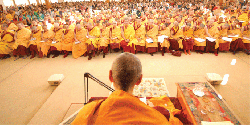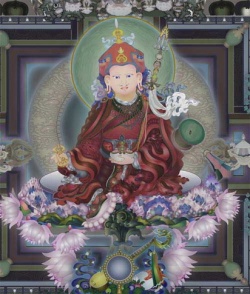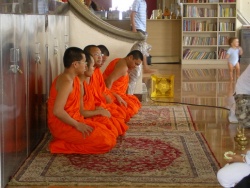Tibetan Buddhist Butter-lamps
Tibetan Buddhist Butter-lamps
In the Tune of Brahma, Shakyamuni Buddha mentioned the 10 benefits of offering lights:
One becomes like the light of the world
One achieves clairvoyance of the pure eye as a human
One achieves the Deva's eye
One receives the wisdom to discriminate virtue from non-virtue
One is able to eliminate the concept of inherent existence
One receives the illumination of wisdom
One is reborn as a human or deva
One receives great enjoyment wealth
One quickly becomes liberated
One quickly attains enlightenment
It is also said, in the second chapter of the Root Tantra of Chakrasamvara: "If you wish for sublime realization, offer hundreds of lights"
~Root Institute, Lama Thubten Zopa.
Khyabje Kalu Rinpoche (d.1989) said that offerings are of three kinds in four levels: Material ones such as butter lamps, imaginary ones that proceed from our minds, and things which are primordially extant. Light is certainly one of the latter; butter one of the first. When you think that along with the flame you are offering your consciousness and/or your energy then the lamp stands for all three.
The tradition of the fire sacrifice is a very ancient, even a prehistoric one. It has always represented the presence of sacred energy, and the ability of human beings to manipulate it. Besides that, fire provides light which is considered pleasing to the eyes of those spiritual beings in whom the senses are predominant.
Symbols and images in Tibetan Buddhism may be examined on three (or 4) levels known as the Outer, Inner and the Secret (also, Hidden.) We can say, therefore, that the outer meaning of the offering of butter lamps is that of one of 6 such virtues, the Perfection of generosity which we achieve by giving away the valuable substance, butter or oil.
As the butter lamps burn, the smoke visible or not, goes to Space.
The Inner meaning has to do with burning up gross matter and transforming it into energy thereby providing light in darkness. Here the lamp has the further, probably universal or archetypal meaning of illuminating wisdom: That which reveals and in so doing chases away shadows and obscurations.
The Secret or trans mutational meaning relates to heat, the unseen energy produced by burning which evokes tummo, one of the Six Yogas of Naropa.
Nagasena, who features in the Buddhist scripture called The Questions of King Milinda, explained rebirth by means of a fire analogy: a lamp or candle passes its flame to another candle. The flame seems to leap from lamp to lamp, but in effect , it is not really the same flame -- nor is it even the same flame from one moment to the next on the original candle, nor in any fire.
Also, Nirvana [[[Pali]]: nibbana] means 'extinction.' The flame is the perfect and brilliant reminder of the teaching question that asks: Where does the fire go when it goes out?
Also, the Arya Maitreya Sutra states, "Those who offer one thousand lights or one thousand blue Utpala flowers or who make the pinnacle of a Stupa, or who make the Holy Form will be reborn when Maitreya Buddha shows the deed of gaining enlightenment, and receive his first Dharma teaching"


